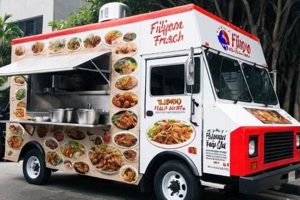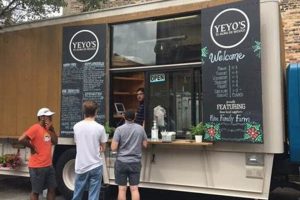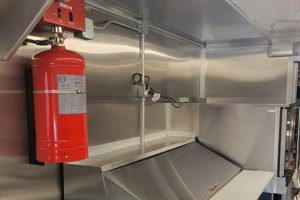The arrangement of equipment and workspaces within a mobile food vending unit, illustrating the spatial relationships and operational flow, constitutes a fundamental design consideration. These layouts dictate the efficiency of food preparation, the safety of personnel, and the overall functionality of the commercial vehicle. For example, a design might feature a central cooking area with surrounding stations for prep, serving, and cleaning, all within a confined space.
Careful consideration of spatial configuration offers numerous advantages. It enhances workflow efficiency, minimizing unnecessary movement and maximizing output. Well-designed arrangements improve sanitation and hygiene, facilitating compliance with health regulations. Historically, the evolution of mobile food vending has driven increasingly sophisticated approaches to interior design, reflecting a growing awareness of the impact of spatial organization on business success. The strategic use of space contributes significantly to operational productivity and profitability.
Therefore, the subsequent sections will address key aspects of spatial arrangement, including design principles, regulatory compliance, common layouts, equipment considerations, and software tools used in the planning process.
Optimizing Mobile Food Unit Layout
Designing an efficient and compliant mobile food unit is crucial for operational success. Careful planning maximizes workspace, ensures food safety, and facilitates smooth workflow. The following considerations offer valuable insights into spatial organization.
Tip 1: Prioritize Workflow Analysis: Evaluate the steps involved in food preparation, from ingredient storage to serving. Optimize the layout to minimize movement and prevent bottlenecks. For example, locate the refrigerator near the prep area to streamline ingredient retrieval.
Tip 2: Adhere to Regulatory Standards: Familiarize yourself with local health codes and regulations pertaining to mobile food units. Ensure adequate handwashing stations, food storage temperatures, and waste disposal systems are integrated into the design. Compliance is non-negotiable.
Tip 3: Maximize Vertical Space: In a confined environment, efficient use of vertical space is essential. Install shelving, racks, and overhead storage to accommodate equipment and supplies without impeding movement. Consider custom solutions tailored to specific needs.
Tip 4: Optimize Equipment Selection: Choose equipment based on both functionality and space efficiency. Compact, multi-purpose appliances can reduce clutter and streamline operations. Prioritize energy-efficient models to minimize power consumption.
Tip 5: Designate Zones for Specific Tasks: Clearly define areas for food preparation, cooking, serving, and cleaning. Separating these functions minimizes cross-contamination and improves hygiene. Use physical barriers or visual cues to delineate these zones.
Tip 6: Ensure Adequate Lighting and Ventilation: Proper lighting is crucial for food safety and employee well-being. Install adequate lighting fixtures throughout the unit. Sufficient ventilation is essential for removing heat, smoke, and odors, creating a comfortable and safe working environment. Exhaust fans and ventilation hoods are vital components.
Tip 7: Plan for Accessibility: Consider the needs of employees and customers with disabilities. Ensure that the unit is accessible by complying with ADA guidelines regarding ramp access, counter heights, and maneuvering space. This demonstrates inclusivity and expands the customer base.
Efficient planning offers tangible benefits, including improved employee productivity, reduced operational costs, and enhanced customer satisfaction. A well-designed workspace promotes safety, efficiency, and profitability.
The following sections will explore the tools and resources available to aid in the design and implementation of layouts.
1. Workflow Optimization
Workflow optimization, when applied to the interior design of a mobile food unit, directly impacts operational efficiency and profitability. The arrangement of cooking equipment, preparation surfaces, storage, and serving areas dictates the movement of personnel and the speed at which orders can be fulfilled. Inefficient designs lead to bottlenecks, increased labor costs, and potentially compromised food quality due to delays. For instance, a poorly positioned refrigerator requiring staff to navigate around cooking equipment to retrieve ingredients creates unnecessary delays and safety hazards. Conversely, a well-planned layout minimizes steps, reduces reaching, and enables seamless transitions between tasks, improving order processing time and employee productivity. The spatial arrangement is therefore not merely aesthetic; it is a fundamental component of operational effectiveness.
The planning phase for a mobile food unit should begin with a thorough workflow analysis. This involves mapping out the entire food preparation process, from ingredient acquisition to final service. Consider peak service times and anticipate potential bottlenecks. The floor plan should then be designed to address these specific needs. For example, if the menu consists primarily of grilled items, the grill should be centrally located with easy access to preparation and serving stations. A dedicated cleaning area with convenient access to water and waste disposal is also essential for maintaining hygiene and regulatory compliance. Successful implementation requires understanding the intricate relationship between each station and how it impacts the overall flow.
Ultimately, the effectiveness of a mobile food unit layout is measured by its ability to streamline operations and maximize throughput. Prioritizing workflow optimization during the design phase minimizes operational inefficiencies, enhances employee satisfaction, and ultimately contributes to the financial success of the business. Regular evaluation and adjustments to the spatial arrangement based on observed performance can further refine the workflow and address unforeseen challenges. Therefore, the link between optimized workflow and effective interior arrangement is critical for the sustainability of a mobile food business.
2. Equipment Placement
The positioning of equipment within a mobile food vending unit directly impacts the efficiency of food preparation, safety of personnel, and compliance with health regulations. Strategically locating essential components is fundamental to creating a functional workspace.
- Workflow Optimization Through Proximity
Proximity between frequently used equipment streamlines operations. For instance, placing the refrigeration unit adjacent to the food preparation station minimizes steps and saves time. Conversely, poorly located equipment can lead to bottlenecks and hinder workflow efficiency. Strategic placement considers the frequency of use and the sequence of food preparation processes.
- Adherence to Safety Regulations
Equipment must be positioned to meet safety requirements. This includes adequate spacing between cooking appliances and flammable materials, as well as sufficient ventilation to remove smoke and fumes. Overcrowding can create hazardous conditions and impede emergency egress. Compliance with fire safety codes is paramount.
- Spatial Efficiency and Multi-Functionality
In the limited space of a mobile food unit, optimizing spatial efficiency is crucial. Multi-functional equipment, such as combination ovens or refrigerated prep tables, can reduce the overall footprint. Equipment placement should also consider potential overlap in usage areas to maximize workspace utilization. Smart design choices enhance productivity.
- Ergonomic Considerations and Employee Comfort
Equipment height and accessibility influence employee comfort and reduce the risk of injury. Placing equipment at appropriate working heights minimizes bending and reaching. Adequate aisle space allows for comfortable movement and reduces the likelihood of collisions. Prioritizing ergonomics improves employee morale and productivity.
Therefore, the strategic arrangement directly affects the operability and profitability of the business. Comprehensive and informed planning, emphasizing these factors, yields functional and efficient mobile food facilities. The successful integration of these components highlights the importance of careful spatial arrangement in optimizing the operational capacity.
3. Regulatory Compliance
Strict adherence to regulatory standards is intrinsically linked to the creation and implementation of layouts for mobile food vending units. These regulations, dictated by local and state health departments, directly influence the physical configuration of the workspace and dictate specific design requirements. Failure to comply results in operational restrictions, fines, or even business closure. The arrangement must, therefore, accommodate necessary elements such as handwashing stations, three-compartment sinks, and adequate refrigeration, as mandated by health codes. Ignoring these requirements during the planning stage can lead to costly redesigns and delays in operation. An example includes the mandatory separation of raw and cooked food storage areas, necessitating dedicated spaces within the layout to prevent cross-contamination. Compliance impacts not only the physical space but also the materials used, requiring food-grade surfaces that are easily cleanable and sanitizable.
Practical application of regulatory knowledge necessitates a thorough understanding of local health codes. This understanding informs every aspect of the spatial design, from the placement of equipment to the selection of building materials. A comprehensive plan incorporates the necessary features to ensure compliance with food safety regulations, waste disposal requirements, and fire safety standards. This includes designing accessible handwashing facilities, ensuring proper ventilation, and providing adequate space for food preparation and storage. Regular inspections by health officials will verify adherence to these codes, making careful planning crucial for obtaining and maintaining operating permits. A layout that initially appears efficient may prove inadequate if it fails to meet regulatory criteria, highlighting the critical interplay between functional design and compliance obligations.
In conclusion, the relationship between spatial arrangement and regulatory compliance is undeniable. The spatial design must prioritize adherence to established health and safety standards. Challenges may arise when attempting to optimize space while satisfying regulatory demands, but a thorough understanding of the relevant codes and proactive integration of these requirements is essential. The emphasis on spatial design will enable operational efficiency and will maintain adherence to required legal operational compliance.
4. Storage Solutions
The allocation of storage space within mobile food units is a critical determinant of operational efficiency and regulatory compliance. Effective design integrates storage solutions seamlessly into the floor plan, maximizing the utility of limited space while adhering to food safety standards. Optimizing storage is not simply about fitting items; it necessitates a strategic approach tailored to the specific needs of the mobile food business.
- Vertical Storage Utilization
Vertical storage capitalizes on the often-underutilized height within a unit. Shelving, racks, and overhead compartments provide accessible storage for dry goods, utensils, and packaging materials. Effective planning vertically reduces clutter and maximizes floor space. Examples include custom-built shelving units that conform to the contours of the unit and suspended racks for storing pots and pans. Vertical solutions must also consider weight distribution to maintain vehicle stability.
- Temperature-Controlled Storage
Refrigeration and freezer units are integral components requiring careful placement within the floor plan. Regulatory standards dictate temperature requirements for various food items, necessitating dedicated storage areas. Examples include under-counter refrigerators, reach-in freezers, and insulated containers. Proper placement ensures easy access for staff while maintaining temperature integrity. Adequate ventilation for refrigeration units is also a critical consideration to prevent overheating and maintain energy efficiency.
- Mobile Storage Solutions
Mobile storage options, such as carts and rolling containers, offer flexibility and adaptability within the floor plan. These units can be easily moved to accommodate changing needs during food preparation and service. Examples include ingredient carts, waste disposal containers, and serving stations on wheels. Mobile solutions contribute to workflow optimization and allow for reconfiguration of the space as needed. Weight capacity and secure locking mechanisms are important factors to consider for safety and stability.
- Specialized Storage for Specific Items
Menu items with specific storage needs, such as produce, meats, or specialty ingredients, necessitate dedicated storage solutions. Produce requires well-ventilated containers to prevent spoilage, while meats must be stored at appropriate temperatures to maintain food safety. Examples include produce racks, meat coolers, and spice organizers. Effective categorization and labeling systems ensure easy identification and retrieval of items, minimizing waste and maximizing inventory management.
Ultimately, the efficacy of storage solutions is measured by their contribution to operational efficiency, food safety, and space utilization. The success hinges on integration with floor plan, in a way that considers safety and regulatory mandates. Effective systems maximize spatial efficiency and support streamlined workflow.
5. Accessibility
Compliance with accessibility standards in mobile food vending units is a significant factor influencing both operational scope and legal standing. Integrating accessibility considerations into spatial arrangement is paramount to ensuring equitable service and adherence to regulatory mandates.
- Ramp Integration and Entry Points
The primary means of accessing a mobile food unit is through the entry point. Designing layouts with ramps or lifts is essential for wheelchair users and individuals with mobility impairments. Ramp gradients must comply with ADA standards to ensure safe and independent access. Integration must also account for sufficient maneuvering space at the entry point to facilitate smooth transitions. The position of the ramp within the spatial layout influences traffic flow and operational efficiency within the unit.
- Counter Heights and Reach Ranges
Service counter heights are critical factors affecting accessibility for customers with disabilities. Counter heights must adhere to specified limits, generally no higher than 36 inches, to ensure that wheelchair users can comfortably interact with staff. Reach ranges for point-of-sale systems, menus, and condiments must also be within accessible parameters. Strategic planning should account for both standing and seated customer interactions to promote inclusivity.
- Interior Maneuvering Space and Aisle Widths
Adequate interior maneuvering space is essential for wheelchair users and individuals using mobility devices to navigate within the mobile food unit. Aisle widths must comply with minimum standards to allow for safe passage and turning. Clear pathways free from obstructions are necessary to prevent accidents and ensure accessibility throughout the unit. The spatial arrangement of equipment and furniture must prioritize maneuverability to accommodate a diverse range of customers.
- Communication Accommodations and Assistive Technologies
Effective communication is a crucial aspect of accessibility. Mobile food units should consider providing accommodations for individuals with hearing or visual impairments. This may include visual menus, tactile signage, or assistive listening devices. Staff training on accessible communication practices is also essential. Integrating these accommodations into the spatial design enhances the overall customer experience for individuals with disabilities.
Effective integration of these accessibility facets within the spatial configuration of mobile food units ensures compliance with legal mandates and promotes inclusivity. Careful planning not only benefits customers with disabilities but also improves overall functionality and customer satisfaction. The incorporation highlights the role of a well-designed, accessible space in modern mobile food vending businesses.
Frequently Asked Questions
The following addresses common inquiries regarding the interior design and spatial configuration of mobile food vending units, providing clarity on key considerations and regulatory requirements.
Question 1: What is the typical size constraint for a mobile food vending unit?
Mobile food units, commonly built on truck or trailer chassis, typically range from 16 to 30 feet in length and 7 to 8.5 feet in width. Interior space is further reduced by equipment and necessary clearances. Exact dimensions vary according to chassis type and local regulations.
Question 2: What is the minimum aisle width mandated in layouts for accessible pathways?
Accessible layouts require a minimum aisle width of 36 inches to accommodate wheelchair maneuverability. Specific regulations may vary based on local ordinances, necessitating confirmation with the relevant authority.
Question 3: What is the recommended height for work surfaces to adhere to ergonomic design principles?
Ergonomic work surfaces generally range from 34 to 36 inches in height. This minimizes strain on the back and shoulders during extended periods of food preparation. Adjustable height work surfaces are available to accommodate individual employee needs.
Question 4: Is a three-compartment sink mandatory in every food vending layout?
Most jurisdictions mandate a three-compartment sink for washing, rinsing, and sanitizing utensils and equipment. Exact requirements are determined by local health codes and may vary based on the specific menu and operational procedures.
Question 5: What ventilation systems must be installed to ensure regulatory compliance?
A ventilation system, including a commercial-grade exhaust hood, is required to remove cooking fumes, heat, and odors. Local fire codes dictate specific installation requirements, including proximity to cooking equipment and fire suppression systems.
Question 6: What materials can be used for wall and floor coverings in commercial vending applications?
Wall and floor coverings must be constructed of smooth, non-absorbent materials that are easily cleanable and sanitizable. Acceptable materials include stainless steel, aluminum, fiberglass reinforced plastic (FRP), and commercial-grade vinyl. Wood and porous materials are generally prohibited.
These responses offer critical insight for those involved in mobile food vending. It is advisable to seek expert consultation.
Subsequent article sections will focus on resource links and contact details.
Conclusion
The preceding discussion emphasized critical aspects of spatial arrangement within mobile food vending units. Key areas explored included workflow optimization, equipment placement, regulatory compliance, storage solutions, and accessibility. Effective integration of these elements is fundamental to establishing a viable and sustainable business operation.
Thorough consideration of layouts, incorporating the principles and regulatory mandates outlined, remains paramount. Continued diligence in the design and implementation stages is essential for ensuring operational efficiency, legal compliance, and ultimately, the long-term success. Further research into local health codes and professional consultation are highly advised for maximizing the potential of each individual unit.







